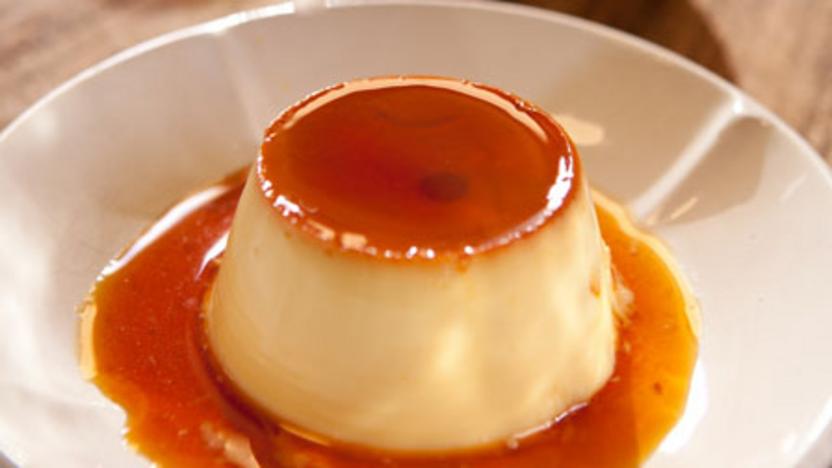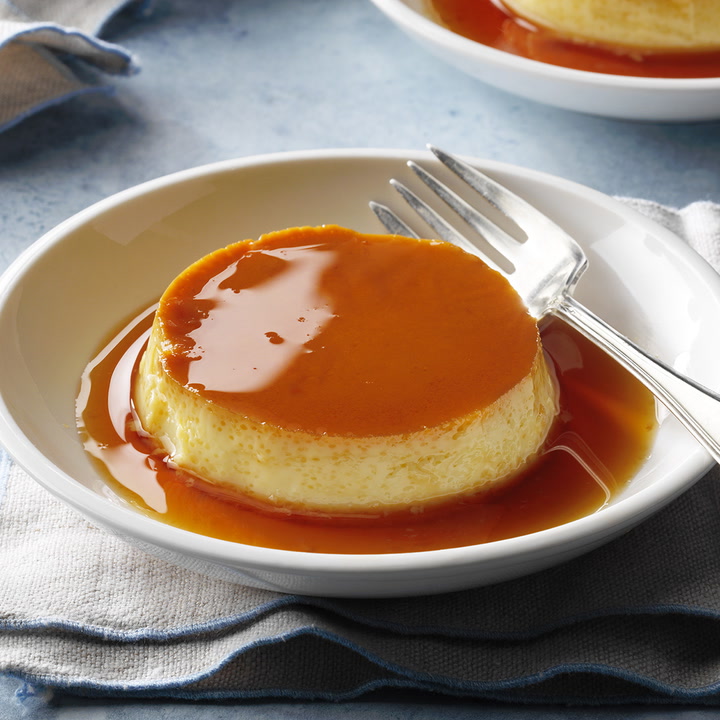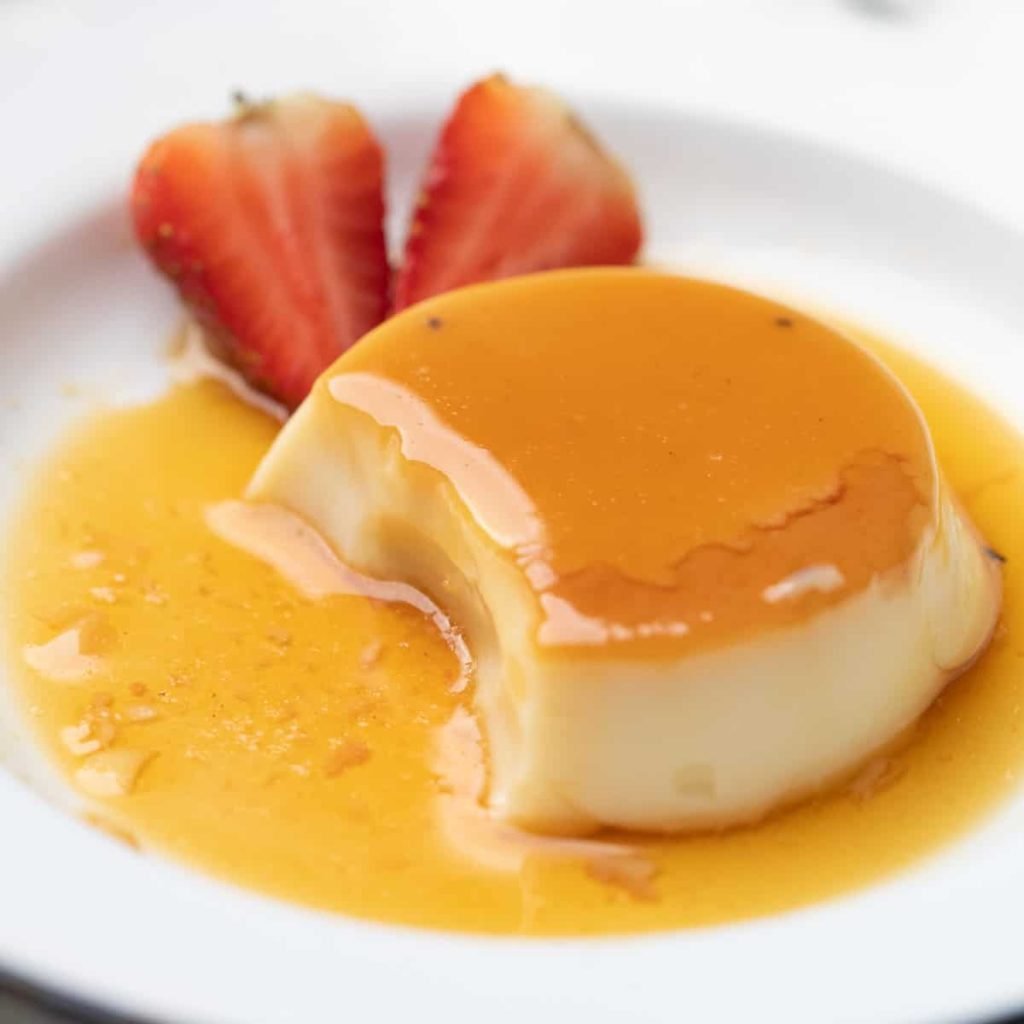Introduction:
Caramelized Custard Recipe often referred to as crème caramel or flan, is a dessert that embodies elegance and simplicity. The combination of silky smooth custard with a layer of rich, golden caramel creates a harmonious blend of flavors and textures that has captivated dessert lovers for generations. If you’ve ever wanted to master this classic treat, this guide will walk you through the process step by step.

Ingredients
For the caramel:
1 cup granulated sugar
1/4 cup water
For the custard:
4 large eggs
1/2 cup granulated sugar
2 cups whole milk
1 teaspoon vanilla extract
A pinch of salt
Equipment
A medium saucepan
Whisk
Baking dish (or individual ramekins)
Large baking pan (for the water bath)
Sieve (optional for a smoother custard)
Step-by-Step Guide to Caramelized Custard
Step 1: Prepare the Caramel
Heat the Sugar: In a medium saucepan, combine the sugar and water. Stir to dissolve the sugar completely.
Cook the Caramel: Place the saucepan over medium heat. Allow the mixture to cook without stirring, letting it turn into a golden brown caramel. This process takes about 8-10 minutes. Keep an eye on it to prevent burning.
Pour the Caramel: Once the caramel reaches the desired color, quickly pour it into the bottom of your baking dish or ramekins, tilting them slightly to ensure an even layer. The caramel will harden as it cools.
Step 2: Prepare the Custard
Warm the Milk: In another saucepan, gently heat the milk until it’s warm but not boiling. This helps the sugar dissolve more easily and prevents the eggs from curdling when mixed.
Whisk the Eggs and Sugar: In a mixing bowl, whisk together the eggs, sugar, vanilla extract, and a pinch of salt until the mixture is smooth and well combined.
Combine with Milk: Slowly pour the warm milk into the egg mixture, whisking constantly to avoid cooking the eggs.
Strain the Mixture (Optional): For an ultra-smooth custard, strain the mixture through a fine sieve to remove any eggy bits.
Step 3: Assemble and Bake
Preheat the Oven: Preheat your oven to 325°F (160°C).
Pour the Custard: Pour the custard mixture over the hardened caramel in your baking dish or ramekins.
Prepare the Water Bath: Place the filled dish or ramekins into a large baking pan. Pour hot water into the pan until it reaches halfway up the sides of the dish. This water bath helps the custard cook evenly and prevents cracking.
Bake: Carefully place the pan in the oven and bake for 45-60 minutes, or until the custard is set but still slightly jiggly in the center. The exact time may vary depending on the size of your dish or ramekins.
Step 4: Cool and Serve
Cool the Custard: Remove the custard from the water bath and let it cool at room temperature for about an hour. Then, refrigerate for at least 4 hours or overnight.
Unmold the Custard: To serve, run a knife around the edges of the custard to loosen it from the dish. Place a serving plate on top and quickly flip it over. The caramel will flow over the custard, creating a luscious sauce.
Tips for Success
Don’t Overcook: Be mindful of the custard’s consistency while baking. Overcooking can lead to a grainy texture.
Caramel Timing: Work quickly when pouring the caramel, as it hardens fast. If it solidifies before you’ve poured it all, you can gently reheat it until it’s liquid again.
Flavor Variations: While vanilla is the classic flavor, you can experiment with other extracts like almond, coconut, or even a splash of rum for a unique twist.
Final Thoughts
Caramelized custard is a timeless dessert that never fails to impress. Its delicate balance of sweetness and creaminess, combined with the rich, golden caramel, makes it a true classic. Whether you’re making it for a special occasion or just to satisfy a sweet craving, this dessert is sure to delight everyone who tastes it. Enjoy your culinary journey into the world of caramelized custard!
Why is my caramel custard not setting?
Caramel custard, with its smooth, creamy texture and rich caramel layer, is a dessert that many aspire to perfect. However, one of the most common challenges home cooks face is when the custard doesn’t set properly. Instead of a firm, sliceable dessert, you might end up with a runny mess. If you’ve been wondering why your caramel custard isn’t setting, here’s a detailed look at the potential reasons and how you can troubleshoot them.
1.Insufficient Cooking Time
Problem: One of the most common reasons for a caramel custard not setting is that it simply hasn’t cooked long enough. The custard mixture needs sufficient time in the oven to coagulate and reach the right consistency.
Solution: Check the custard after the recommended baking time, but don’t rush to take it out if it’s still wobbly in the center. Custards should be firm but slightly jiggly in the center when done. If it’s too liquid, extend the baking time by 5-10 minutes and keep checking it.
2.Incorrect Oven Temperature
Problem: Another potential culprit is incorrect oven temperature. If your oven is too hot, the custard may curdle instead of setting properly. Conversely, if the temperature is too low, the custard won’t set in the time given.
Solution: Use an oven thermometer to ensure your oven is at the correct temperature, typically around 325°F (160°C). If you notice that your oven runs hotter or cooler than the dial indicates, adjust the temperature accordingly.
3.Poor Water Bath Technique
Problem: Caramel custard is traditionally baked in a water bath, which helps regulate the temperature and prevent the custard from overheating. If the water bath isn’t prepared correctly, the custard may not set.
Solution: Ensure that the water bath is filled with hot water that reaches halfway up the sides of your baking dish or ramekins. This creates a gentle, even cooking environment. If the water level is too low or the water isn’t hot enough, the custard may not cook evenly and fail to set.
4.Incorrect Proportions of Ingredients
Problem: The ratio of eggs to milk (or cream) in your custard mixture is crucial. Too much milk or not enough eggs can prevent the custard from setting properly.
Solution: Stick to the recipe’s proportions, especially if you’re trying it for the first time. Typically, a basic custard recipe requires 2 cups of milk for every 4 large eggs. Adjusting this ratio can result in a custard that’s too loose.
5.Overmixing the Custard
Problem: When preparing the custard, overmixing the eggs and milk can incorporate too much air into the mixture. This can result in a lighter texture that doesn’t set properly.
Solution: Mix the custard gently until just combined. Avoid vigorous whisking, which can introduce air bubbles and prevent the custard from setting as it should.
6.Custard Removed Too Soon from the Oven
Problem: Even if the custard appears set when you take it out of the oven, it may still need time to finish setting as it cools. Removing it too soon can result in a custard that doesn’t hold its shape.
Solution: After baking, allow the custard to cool in the water bath for a bit before transferring it to the fridge. The cooling process is crucial for the custard to firm up completely.
7.Inadequate Cooling Time
Problem: Caramel custard needs time to cool and set properly. If you try to unmold or serve it too soon, it may still be too soft.
Solution: After baking, let the custard cool at room temperature for about an hour, then refrigerate it for at least 4 hours or overnight. This chilling time is essential for the custard to set fully.
Final Thoughts
Making caramel custard can be a bit tricky, but understanding the science behind why it might not set can help you troubleshoot and improve your technique. Whether it’s adjusting your baking time, ensuring your oven is at the right temperature, or refining your water bath technique, each step plays a crucial role in achieving that perfectly set, smooth caramel custard. With patience and attention to detail, you’ll soon be serving a dessert that’s as delicious as it is beautiful.
Where is caramel custard from?
Caramelized Custard Recipe also known as crème caramel or flan, is a dessert that transcends borders and has been embraced by many cultures around the world. Its origins are a fascinating tapestry woven through history, influenced by the culinary traditions of Europe, the Middle East, and Latin America. But where exactly did this beloved dessert come from, and how did it become a global favorite?

The European Roots: France and Spain
Caramel custard is often associated with European cuisine, particularly French and Spanish. The French version, known as crème caramel, is a staple in French patisseries and is characterized by its smooth, creamy texture and a delicate layer of caramel. The dish is a refined take on custards that have been made in Europe for centuries.
In Spain, a similar dessert called flan has been enjoyed for generations. The Spanish flan is almost identical to the French crème caramel, with a rich caramel sauce that gives it a slightly different flavor profile. Flan became popular in Spain during the Roman Empire, and the Romans are believed to have introduced the concept of custard-based desserts to the region.
Ancient Influences: The Middle Eastern Connection
The concept of custard, a mixture of eggs and milk thickened with heat, can be traced back to the Middle East. The Arabs were skilled in cooking with sugar, and during the medieval period, they developed a variety of sweet dishes that spread throughout Europe. It is believed that the technique of making custard, combined with the art of caramelizing sugar, found its way to Europe through the Moors in Spain.
The Global Spread: Latin America and Beyond
The Spanish colonization of the Americas in the 16th century played a significant role in spreading caramel custard to Latin America, where it quickly became a beloved dessert. In countries like Mexico, Cuba, and Puerto Rico, flan is a traditional dish that is often served during celebrations and family gatherings.
Each region in Latin America has its own variation of flan, often incorporating local ingredients like condensed milk, coconut, or even cheese. This adaptability and the ease of making flan contributed to its widespread popularity across the continent.
Modern Variations and Global Influence
Today, caramel custard is enjoyed worldwide, with each region adding its own unique twist. In the Philippines, leche flan is a richer version of the dessert, made with more egg yolks and often served at festive occasions. In Japan, purin is a popular custard pudding similar to flan, but with a lighter texture, reflecting the Japanese palate’s preference for less sweet desserts.
Even in places like India, caramel custard has found a home, often served in Anglo-Indian communities and known for its slightly denser texture.
A Dessert That Unites
Caramel custard’s journey from ancient kitchens to modern dining tables is a testament to its universal appeal. Whether it’s called crème caramel, flan, purin, or leche flan, this dessert has the power to bring people together across cultures and generations. Its smooth, creamy texture and rich caramel flavor are timeless, making it a cherished dish that continues to evolve and inspire.
In essence, caramel custard is a global dessert with a rich history that spans continents. Its origins may be rooted in European and Middle Eastern culinary traditions, but its journey through Latin America and beyond has made it a beloved treat worldwide.
Why is my caramel custard watery?
Caramel custard, also known as crème caramel or flan, is a dessert that promises a silky, smooth texture with a rich caramel sauce. However, achieving this perfect consistency can sometimes be challenging. If you find that your caramel custard has turned out watery instead of firm and creamy, you’re not alone. Understanding why this happens can help you troubleshoot and perfect your recipe. Here’s a comprehensive look at the possible reasons and solutions for watery caramel custard.
1.Incorrect Egg-to-Milk Ratio
Problem: The ratio of eggs to milk is crucial in achieving the right texture for caramel custard. Eggs are the key setting agent in custard, and if there aren’t enough eggs relative to the amount of milk, the custard may not set properly, resulting in a watery texture.
Solution: Stick to a tried-and-true recipe that balances the egg-to-milk ratio. A standard guideline is to use 4 large eggs for every 2 cups of milk. This ratio provides enough structure for the custard to set while maintaining a creamy consistency.
2.Overheating the Milk
Problem: If you overheat the milk while preparing the custard mixture, it can cause the proteins in the milk and eggs to denature, leading to a watery texture once baked.
Solution: Gently warm the milk until it’s just hot to the touch, around 160°F (70°C). The milk should be warm enough to dissolve the sugar but not so hot that it begins to cook the eggs when mixed together.
3.Improper Mixing Technique
Problem: Overmixing the custard mixture can incorporate too much air, which may lead to a lighter texture that doesn’t set properly. Conversely, under-mixing can result in an uneven distribution of ingredients, causing some parts to set while others remain watery.
Solution: Whisk the eggs, sugar, and milk just until they are well combined and smooth. Avoid vigorous mixing, as this can introduce air bubbles that affect the texture.
4.Baking at the Wrong Temperature
Problem: Baking caramel custard at a temperature that is too high or too low can result in a watery texture. If the oven is too hot, the custard may curdle and separate, leading to a watery consistency. If the temperature is too low, the custard may not set properly.
Solution: Bake the custard at a low and steady temperature, typically around 325°F (160°C). Use an oven thermometer to ensure accuracy, as oven temperatures can vary.
5.Skipping or Improper Use of the Water Bath
Problem: A water bath (or bain-marie) is essential for caramel custard because it provides gentle, even heat. Without it, the custard is more likely to overcook or cook unevenly, leading to a watery or curdled texture.
Solution: Place the ramekins or baking dish in a larger pan and fill the pan with hot water until it reaches halfway up the sides of the custard dishes. This water bath ensures a slow, even bake that prevents the custard from curdling or becoming watery.

6.Not Enough Baking Time
Problem: If the custard is underbaked, it will not have enough time to set properly, resulting in a watery consistency.
Solution: Bake the custard until it is just set around the edges but still slightly jiggly in the center. The custard will continue to set as it cools. Depending on the size of your dish or ramekins, baking time can range from 45 minutes to an hour. Blend ripe mango chunks with water or milk, sugar, and a splash of lemon juice. Strain, chill, and serve fresh for a refreshing mango juice!”
7.Insufficient Cooling Time
Problem: Caramel custard needs time to cool and fully set. If you try to unmold or serve the custard too soon, it may still be too soft and appear watery.
Solution: After baking, allow the custard to cool at room temperature for about an hour, then refrigerate it for at least 4 hours, or preferably overnight. This cooling period is crucial for the custard to firm up completely.
8.Using Low-Fat Milk or Alternative Milk
Problem: Using low-fat or non-dairy milk alternatives can affect the setting properties of caramel custard, leading to a thinner, more watery texture. Whole milk is preferred because the fat content helps create a rich, creamy consistency.
Solution: For best results, use whole milk or a mixture of whole milk and cream. If you prefer using alternative milks, consider adding an extra egg or egg yolk to help the custard set. Mix rose syrup, milk, basil seeds, vermicelli, and ice cream. Top with nuts and serve chilled for a perfect Falooda!”
Final Thoughts
Caramelized Custard Recipe can be a delicate process, but understanding the factors that can lead to a watery texture is the first step toward perfecting this classic dessert. By paying close attention to the egg-to-milk ratio, baking temperature, and cooking technique, you can create a caramel custard that is rich, smooth, and perfectly set. With practice and patience, you’ll be able to troubleshoot and refine your approach, ensuring that your caramel custard turns out beautifully every time.
As an Amazon Associate, We earn from qualifying purchases. When you purchase a product through Amazon links on kitchenadvising.com, we may earn a small commission at no extra cost to you. This helps support the site and keep our content free.


